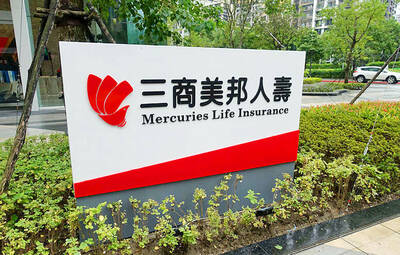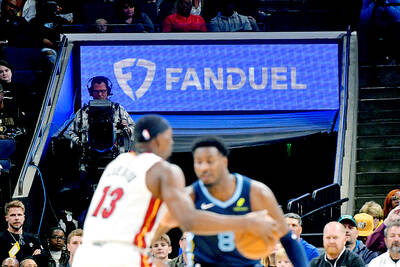Micron Technology Inc is poised to land about ¥200 billion ($1.5 billion) in financial incentives from the Japanese government to help it make next-generation memory chips in the country, according to people familiar with the matter, the latest step in Tokyo’s effort to bolster domestic semiconductor production.
The US company will use the money to install advanced, EUV chipmaking equipment from ASML Holding NV at its facility in Hiroshima to fabricate DRAM chips, said the people, asking not to be identified because the agreement isn’t public. The funding is likely to be announced as Japanese Prime Minister Fumio Kishida was to meet yesterday with a delegation of chip executives, including Micron chief executive officer Sanjay Mehrotra.
Tokyo Electron Ltd spearheaded a rally in chipmaking gear suppliers, particularly those that provide gear or technology that support EUV.

Photo: REUTERS
The financing is the latest sign of Japan’s ambitions in developing its own semiconductor industry, a potential backup to Taiwan amid intensifying tensions between the US and China. The government is already spending billions of dollars to encourage Taiwan Semiconductor Manufacturing Co (台積電) to add production capacity in the country, and to finance a domestic chip venture, Rapidus Corp, with aspirations to make 2-nanometer chips by 2027.
The Micron deal will bring EUV equipment to Japan for the first time, a step toward cutting-edge manufacturing the government has sought.
The agreement is also a retort to Beijing, which launched a cybersecurity review of the Boise, Idaho-based company after US President Joe Biden's administration leveled sweeping restrictions on chip-related exports to China. That threatens the last American memorychip maker’s ability to sell into China, where it now gets about 11 percent of its revenue.
Kishida would receive leaders from the Group of Seven countries, including Biden, in Hiroshima between May 19 and May 21.
“Micron’s Hiroshima factory will play a key role in the G-7’s ambition to strengthen semiconductor chip supply chains,” said Akira Minamikawa, an analyst with the research firm Omdia. “It is the most important location for the US company.”
Micron’s Hiroshima factory, a former production site for the now-defunct Elpida Memory Inc, houses some of the US firm’s best engineers, Minamikawa said. Japanese Ministry of Economy, Trade and Industry said last year it would provide as much as ¥46.5 billion to Micron for production at the facility.
The US company has invested more than US$13 billion in Japan since 2013, including for a push last year to produce what it calls one-beta DRAM chips. The latest funding will help Micron produce with what it calls one-gamma production, a more advanced technology that Micron plans to launch later next year. Suppliers that will benefit from Micron’s investments include Tokyo Electron Ltd, as well as ASML of the Netherlands.
Micron is expected to contribute its own capital to the Hiroshima expansion, although the specific amount could not be learned. The city of Hiroshima is also expected to support the project.
Micron survived fierce industry consolidation through a string of acquisitions in prior downturns. While it’s added scale, something that helps with the brutal cost competition of manufacturing memory, it’s still much smaller than Samsung Electronics Co, the leader in the memory chip industry.
As the industry hit a supply glut this year, Micron reported a loss of more than US$2 billion in the latest quarter, as the selling price of memory chips fell below the cost of production. Micron’s management reacted with what they called a historically quick response, cutting pay, jobs and production and calling on its peers to follow suit. The company has said that the second half of this year should prove the bottom for the market for DRAM particularly if others also cut production.
The only other US company still involved in the memory chip industry at scale is Western Digital Corp, which doesn’t manufacture its own products, instead relying on partner Kioxia Corp’s facilities in Japan to make flash memory. Micron has used its status as the lone US memory maker to push Washington to subsidize the return of domestic manufacturing in the US. Its executives have been leading voices in the lobbying of government.
Unlike rivals Samsung and SK Hynix Inc, Micron didn’t move any of its wafer fabrication work to mainland China. Outside of its home country, Micron has plants in Taiwan, Singapore and Japan, holdovers from past acquisitions.
While that makes Micron less vulnerable to any actions by Beijing, its close relationship with Washington’s efforts to bolster chip production domestically may have contributed to China’s regulatory scrutiny. Like other US chipmakers, Micron is still dependent on the global electronics supply chains that often run through Chinese factories.

Mercuries Life Insurance Co (三商美邦人壽) shares surged to a seven-month high this week after local media reported that E.Sun Financial Holding Co (玉山金控) had outbid CTBC Financial Holding Co (中信金控) in the financially strained insurer’s ongoing sale process. Shares of the mid-sized life insurer climbed 5.8 percent this week to NT$6.72, extending a nearly 18 percent rally over the past month, as investors bet on the likelihood of an impending takeover. The final round of bidding closed on Thursday, marking a critical step in the 32-year-old insurer’s search for a buyer after years of struggling to meet capital adequacy requirements. Local media reports

US sports leagues rushed to get in on the multi-billion US dollar bonanza of legalized betting, but the arrest of an National Basketball Association (NBA) coach and player in two sprawling US federal investigations show the potential cost of partnering with the gambling industry. Portland Trail Blazers coach Chauncey Billups, a former Detroit Pistons star and an NBA Hall of Famer, was arrested for his alleged role in rigged illegal poker games that prosecutors say were tied to Mafia crime families. Miami Heat guard Terry Rozier was charged with manipulating his play for the benefit of bettors and former NBA player and

The DBS Foundation yesterday announced the launch of two flagship programs, “Silver Motion” and “Happier Caregiver, Healthier Seniors,” in partnership with CCILU Ltd, Hondao Senior Citizens’ Welfare Foundation and the Garden of Hope Foundation to help Taiwan face the challenges of a rapidly aging population. The foundation said it would invest S$4.91 million (US$3.8 million) over three years to foster inclusion and resilience in an aging society. “Aging may bring challenges, but it also brings opportunities. With many Asian markets rapidly becoming super-aged, the DBS Foundation is working with a regional ecosystem of like-minded partners across the private, public and people sectors

BREAKTHROUGH TECH: Powertech expects its fan-out PLP system to become mainstream, saying it can offer three-times greater production throughput Chip packaging service provider Powertech Technology Inc (力成科技) plans to more than double its capital expenditures next year to more than NT$40 billion (US$1.31 billion) as demand for its new panel-level packaging (PLP) technology, primarily used in chips for artificial intelligence (AI) applications, has greatly exceeded what it can supply. A significant portion of the budget, about US$1 billion, would be earmarked for fan-out PLP technology, Powertech told investors yesterday. Its heavy investment in fan-out PLP technology over the past 10 years is expected to bear fruit in 2027 after the technology enters volume production, it said, adding that the tech would